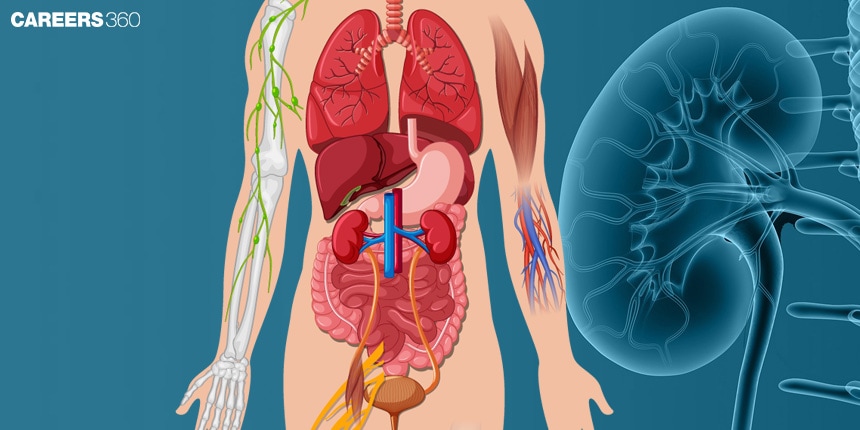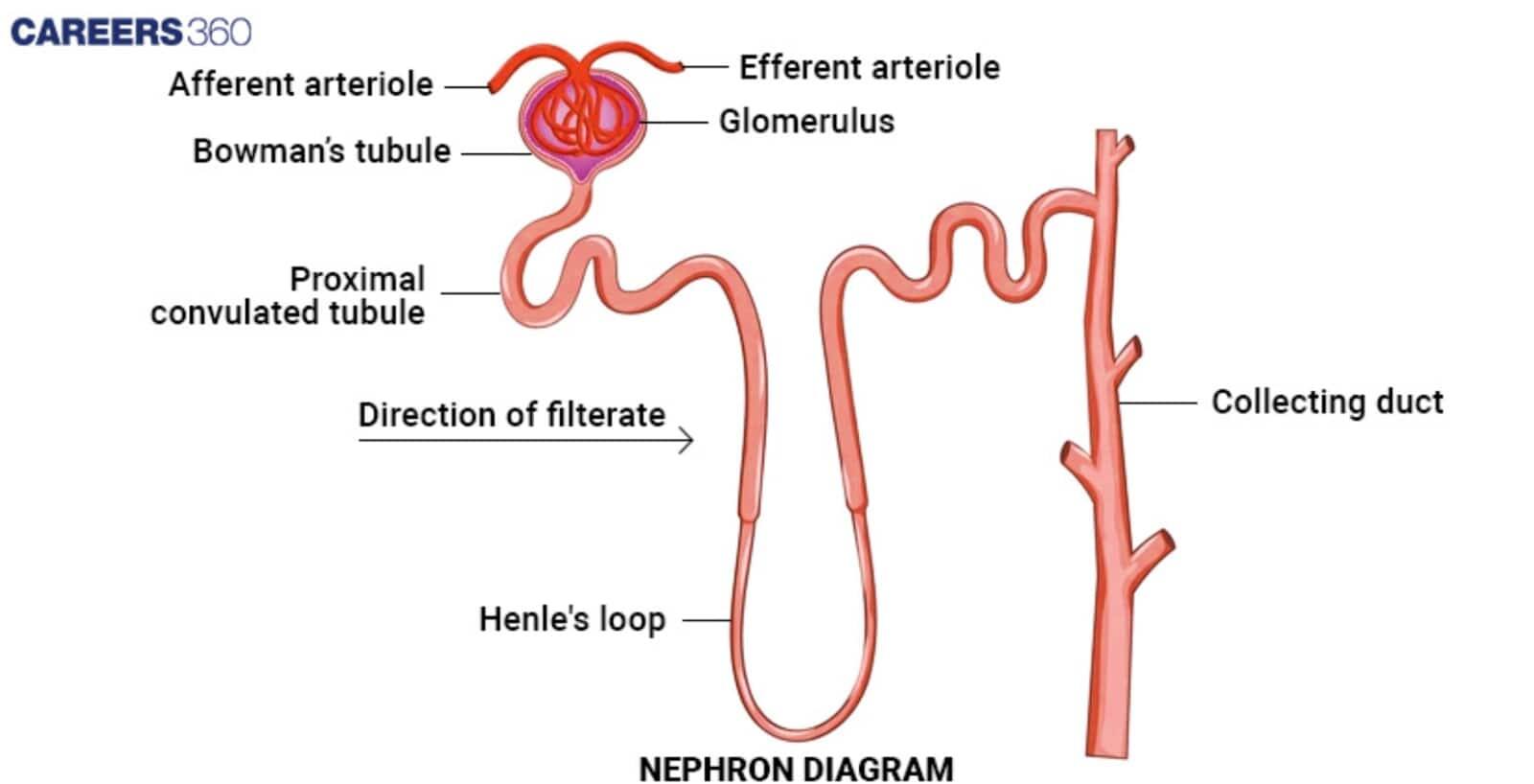Nephron- Function Of Renal Tubules: Definition, Structure, Diagram, & Facts
Nephrons are the structural units of the kidney, serving the crucial function of blood filtration and urine formation. Every nephron is divided into two major parts: the renal corpuscle, comprising the glomerulus and Bowman's capsule, and the renal tubule, further divided into segments including the proximal tubule, loop of Henle, distal tubule, and collecting duct. Nephrons' structure allows for the effective filtration, reabsorption, and secretion required for the maintenance of fluid and electrolyte balance in the body. This is a topic from the Excretory Products And Their Elimination chapter of Biology.
This Story also Contains
- What is Nephron?
- Structure of a Nephron
- Functions of Renal Tubules

What is Nephron?
The nephron is the structural and functional unit of the kidney and is, thus, involved in an important role concerning blood filtration and homeostasis, much like the entire renal system. There are around one million nephrons in each kidney that remove waste products, balance electrolytes, and regulate blood pressure. The nephron is composed of a renal corpuscle and renal tubules, which further comprise a proximal convoluted tubule, a Loop of Henle, a distal convoluted tubule, and a collecting duct. All these parts work as a group to carry out the vital processes of filtration, reabsorption, secretion, and excretion to maintain homeostasis and ensure a body remains fit and healthy.
Also Read:
Structure of a Nephron
The structure of the nephron is discussed below-
Glomerulus
The glomerulus sits at the very start of the nephron and conducts the initial step of filtering the blood. As a result of the severe blood pressure the water, salts and small molecules are forced out from the blood into Bowman's capsule, thus producing the filtrate.
Bowman's Capsule
The Bowman's capsule is a double-walled cup-like structure. It encloses the glomerulus and receives the filtrate secreted from the glomerulus, which it conveys to the renal tubules to continue with the process. Renal Tubules
Renal Tubules
Proximal Convoluted Tubule: This is the first part of the renal tubule which comes out from Bowman's capsule. The PCT is highly coiled, thus providing a large surface area for reabsorption with the lining of microvilli. Significant reabsorption of water, glucose, ions, and other vital nutrients into the bloodstream occurs here.
Loop of Henle: In this region, one would expect to see the loop of an arch extending into the renal medulla. This would contain the descending limb responsible for re-absorbing water and the ascending limb, which re-absorbs salts. The Loop of Henle is involved in an essential process in the concentration of urine.
Distal Convoluted Tubule (DCT): More reabsorption and secretion take place here. Under the control of hormones, the DCT fine-tunes filtrate composition with the reabsorption of more ions and water, e.g., aldosterone.
Collecting Duct: It receives urine from many nephrons and further processes it to end the process of urine concentration by the reabsorption of water under the control of ADH. Concentrated urine is then transported towards the renal pelvis and thence into the ureter.
Diagram: Structure of a Nephron

Functions of Renal Tubules
The function of the nephron is discussed below-
Proximal Convoluted Tubule (PCT)
Reabsorption at the PCT comprises mainly essential nutrients, such as glucose, and amino acids, and ions such as sodium, potassium, and bicarbonate.
In the PCT, approximately 65-70% of the filtrate is reabsorbed.
Some waste products, such as hydrogen ions, creatinine, and some drugs and toxins, are secreted by the PCT into the filtrate to be eliminated as urine.
Loop of Henle
The descending limb of the Loop of Henle reabsorbs water since it is permeable to water though it's not permeable to salts. As the filtrate descends, water moves out of the filtrate and into the surrounding hypertonic medulla, hence concentrating the filtrate.
The ascending limb is impermeable to water. It is the site where active transport expels sodium and chloride ions from the filtrate, thus decreasing the osmolarity of the filtrate.
The countercurrent multiplier system of the Loop of Henle establishes a gradient in the renal medulla. This gradient is what allows the kidney to produce concentrated urine.
Distal Convoluted Tubule (DCT)
The DCT makes state adjustments in the amount reabsorbed based on the needs of the body.
Many ions (such as potassium, sodium, and calcium) are controlled there, along with the control of blood pH by the secretion of hydrogen versus the reabsorption of bicarbonate.
The functions of DCT are influenced by aldosterone and ADH.
For instance, aldosterone increases the re-absorption of sodium and, therefore, in case of more re-absorption of sodium, the secretion of potassium also increases in an equal amount of sodium re-absorbed.
While ADH increases the reabsorption of water.
Collecting Duct
It is responsible for regulating the final concentration of the urine to be excreted. It reabsorbs water under the influence of ADH.
There is more passageway of water passage through the wall of ducts due to increased permeability.
Water and electrolyte balance gets regulated at the collecting ducts by reabsorption of sodium and secretion of potassium and hydrogen ions.
The collecting duct also contributes to the secretion of hydrogen ions and reabsorption of bicarbonate in maintaining acid-base balance.
Also Read
Recommended video for "Nephron- Function Of Renal Tubules"
Frequently Asked Questions (FAQs)
ATN, PKD, and RTA are some of the more common disorders among the many that affect the renal tubules. Of course, the symptoms are dependent on whichever disease presents cases of fatigue, swelling, changes in urine production, electrolyte imbalances, and severe cases, of ney failure have been reported.
The Loop of Henle uses the countercurrent multiplier system to concentrate urine. Water gets reabsorbed in the descending limb, thereby concentrating the filtrate; on the other hand, sodium and chloride ions are reabsorbed in the ascending limb without water to follow, thereby creating a gradient that helps concentrate urine in the medulla.
Among the important substances reabsorbed in the PCT are water, glucose, amino acids, sodium, potassium, bicarbonate, and other vital nutrients. This is an important stage in conserving imperative nutrients, water, and electrolytes in the body.
ADH (antidiuretic hormone) is released to increase water reabsorption in the distal convoluted tubule (DCT) and collecting duct. It increases the permeability of DCT and collecting duct for water. Aldosterone: It is a hormone which acts on the DCT and causes increased reabsorption of sodium and increased secretion of potassium. The relationship of the aldosterone to the electrolyte balance with its effect on the bloodstream content of sodium and potassium helps/assists in the regulating of blood.
The major function of the renal tubules is to process the filtrate produced by the glomerulus through reabsorption, secretion, and excretion, such that the proper body balance of water, electrolytes, and waste products are maintained and urine is formed ready to be excreted out of the body.